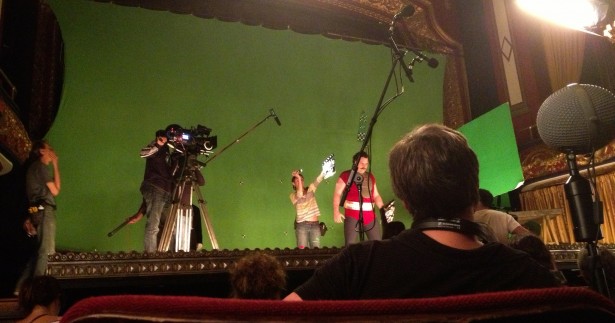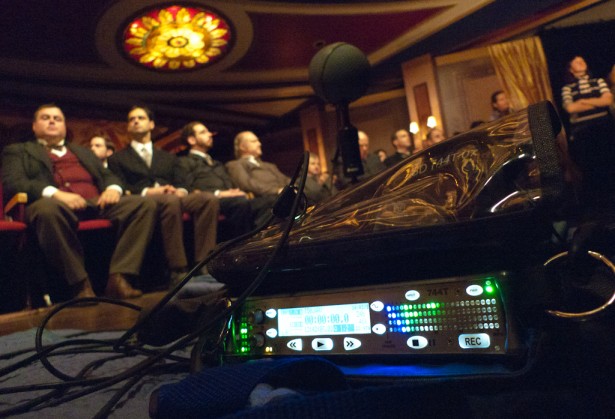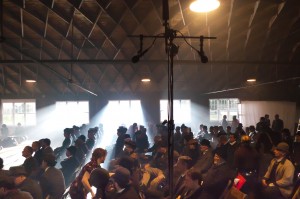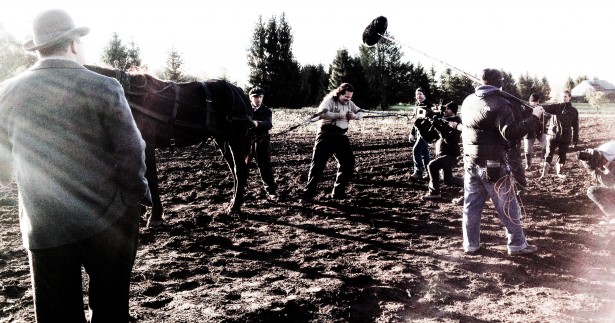Sound recording on the set of the film Louis Cyr

We really benefit from getting involved early in the production process of a film. A good place to start is by reading and analyzing the script in order to evaluate the sound budget in regards to the different fields of sound postproduction: Dialogue, Foley, Sound Effects, and eventually Mix. It is also a good time to evaluate the specific needs a project will have in terms of requested sound. One of my latest films is about a French Canadian, Louis Cyr, who became the strongest man of the world in 1892! As much of his story involves him performing his strength in front of audiences around the world, the film has many scenes involving crowds. For these, I suggested being on set during six of the shooting days as a second sound recording team. These days on the set were very valuable and a great learning experience, both as a sound recordist and for the steps ahead in postproduction.
It was an occasion to meet with Simon Poudrette and Norman Bernard, respectively sound recordist (mixer) and boom operator. They were very generous in welcoming us (my assistant sound designer Paul Col and I), helping us to improve our recording habits. Although it is quite obvious that a location sound recordist and a sound designer should meet prior to and during the shoot (to unite their efforts by discussing the script, field information, and potential difficulties, as well as sharing valuable information about location sound recording strategies), there are often a lot of things that prevent this from happening. I put my energy in the opposite direction, this time with success!
Continue reading to listen to multiple stereophonic microphone comparison!
Through our meeting, we were able to identify which parasite sounds are more problematic than others; electricity sounds with hums and tones can more easily be removed, whereas those that are sporadic and harder to remove, specifically if recorded directly in the dialogue (radio mics glitches, pops, muffled cloth movement sounds, and any strong noise of the real world). He shared his frustration about parasite sounds from the surroundings like airplanes (specially for a period film) and sounds with wider frequency range that come closer to the human voice and therefore are harder to filter. Normally everyone on set focuses on what is happening on the screen, but the sound recordist is also concerned about sounds that occur off screen that will inevitably be captured by his microphones, a reality that is sometimes difficult to work with, especially on a set that always battles against time.
Directors and producers have come to think that we can address and solve most of these sound problems during the post-production process. Unfortunately, we are partly responsible for giving that impression. Who has not heard “We’ll fix that in post-production or at the mix”? They tend to forget another truth: well recorded sound right from the beginning will save time and money later, and will improve the overall quality of the sound project.
Sound should be treated with respect on set so that when it gets in postproduction, we can focus on creativity, rather than on fixing problems. In post-production, we can hide or remove unwanted sounds, but we can rarely improve the sound quality and richness of the original recordings.
On the set, the sound recordist’s main responsibility is to record the dialogue of actors
properly in a combination of boom and radio mics so that all the dialogues are well and cleanly recorded such that we will have the raw elements and multiple options should we need to fix something through editing or alternate takes. Ambiences and sound effects are not their first priority. The habit of recording wild sound effects during shoot has been less valorized lately and has become not always possible because of production circumstances. With the arrival of multi-track recorders, it is now possible to have stereo microphones (in addition to the primary microphones) in order to pick up ambiences and sound effects. I encourage sound recordists to acknowledge our sound design needs and to participate more actively in the overall sound of a project by adding microphones to capture sound effects along with dialogue, before it’s too late! Refer to my previous post for more informations on recording M/S during shoot.
As a second sound team, I was able to focus specifically on crowds with a separate recorder and different stereo microphones. Recording in stereo brings a much richer sound than mono, as our brain is able to determine where the sound comes from. It also gives more information about the room’s acoustics, a large part of what makes it credible.
 We tried a few multi-track timecode synced recorders throughout the shoot: the Zaxcom
We tried a few multi-track timecode synced recorders throughout the shoot: the Zaxcom
Nomad 6, a Sound Devices 788t and a Sound Devices 744t were tested. Jam syncing the timecode in the morning with Simon was very exciting for me. We were able to automatically conform these sounds to picture during postproduction. I felt comfortable in terms of quality with all these recorders. Having access to timecode and multiple mic inputs, great preamps, and good headphone amps convinced me to buy one. My choice went towards the Zaxcom Nomad Lite, for the price and the 6 mic inputs.
 As for microphones, I was able to compare a pair of Sennheiser MKH8040 mounted in ORTF along with the M/S Schoeps microphones. These sessions were an occasion to record in ORTF format, recognised for its large stereo spread. We also experimented with the longer Grace Design stereo bar, spacing the mics up to 55 cm to enlarge the crowd width! It surely did it! We also had a Rolland R-26 with it’s internal mics and a pair of DPA 4060 in a binaural configuration.
As for microphones, I was able to compare a pair of Sennheiser MKH8040 mounted in ORTF along with the M/S Schoeps microphones. These sessions were an occasion to record in ORTF format, recognised for its large stereo spread. We also experimented with the longer Grace Design stereo bar, spacing the mics up to 55 cm to enlarge the crowd width! It surely did it! We also had a Rolland R-26 with it’s internal mics and a pair of DPA 4060 in a binaural configuration.
Just as it is when it’s time to compare speakers, it is very valuable to compare microphones with the same sound source.
Have a listen in comparing the ORTF and M/S.
I see the advantages in both of these captations
Here is another example in comparing all the microphones on set:
.
I noticed many differences between the sets of microphones:
ORTF stereo microphones Sennheiser MKH8040
– Lower noise floor
– greater stereophonic image
– very good bass and round voices
– more sensitive at longer distance
– good dynamic
M/S stereo microphones – Schoeps MK4 and MK8
– good center
– brighter in the mid
– good feeling of the room
Binaural stereo microphones – DPA 4060
-diffuse stereophonic image
-acoustic of the room because of the omni-directional microphones
-bass frequency
XY et OMNI , 2 stereo microphones – Roland R-26,
-noise floor very present
-limited stereophonic image
-more sensitive with proximate action


métier et art très complexe,bravo!
Je viens de découvrir votre site.
En tant que preneur de son VL (Vidéo-Légère) c’est avec le plus grand intérêt que j’ai lu vos articles mais surtout écouté vos extraits sonores.
Votre passion pour l’univers sonore n’a d’égale que votre rigueur à le capter. J’apprécie grandement que vous preniez le temps de partager vos connaissances ainsi que vos expériences.
À partir de maintenant, vous avez donc 2 oreilles de plus à l’écoute d’une passion commune.
Au plaisir,
Daniel Guilbeault
Bien heureux de partager ma passion du son. Au plaisir de collaborer ensemble!